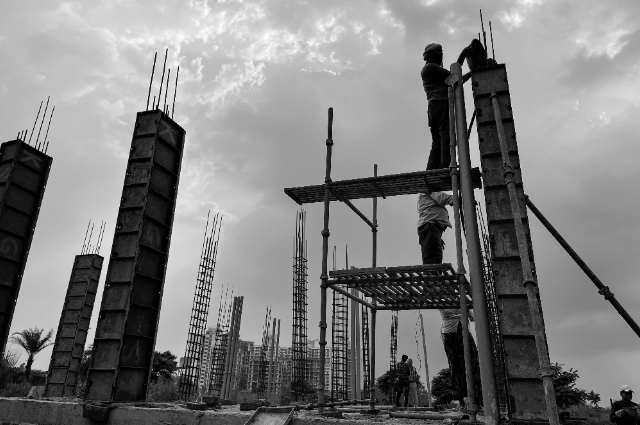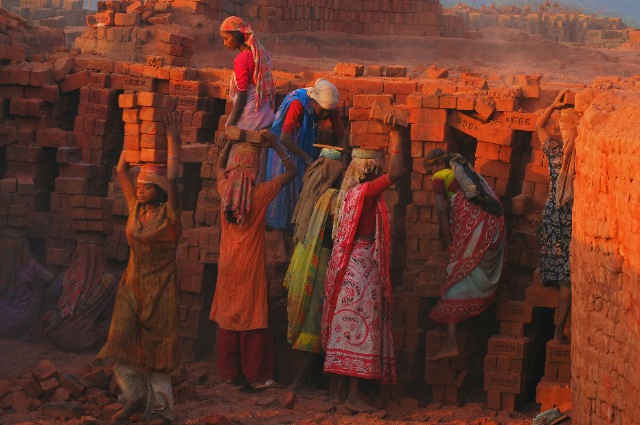
Workers at a construction site, Rasulpur, India / Photo by Nishant Aneja Pexels
On a bright summer morning, on my way to college, something that had never felt significant suddenly stood out to me. The sight of an empty land ready to bear a mid-rise apartment on its soil. How did I miss this sight? Probably, I never cared much when those loud construction noises were just annoying wake-up calls every morning. I was lost in thought about the new apartment until a different sight snapped me back to reality - the relentless effort of the construction workers. To me, their hard work and struggles shone brighter than the morning light.
As I watched them work, a humorous quote by John "Hammer" McLeod crossed my mind: “When in doubt, remember that a construction site is the only place where you get to hit things to make them work.” And amusingly, he was right. The ear-piercing noise and chaotic scene were more than just bricks and buildings. As I returned to the same place each day, their unseen struggles and life stories became more vivid to me. That was when I knew I would embark on a profound journey of uncovering them.
Pillars of strength - The role
Labelled as “backbone of the construction industry,” construction workers play a crucial role in several projects, from small-scale residences to large-scale infrastructures. The demand for skilled workers is gradually increasing with the upsurge in construction projects all over the country. A large team of skilled workers seamlessly perform various tasks on-site, such as loading and unloading materials, laying foundations, formwork and shuttering, reinforcement work, pouring concrete and curing, laying bricks and masonry work, plastering and finishes, and more. Construction workers take up unique roles as Carpenters, Electricians, Plumbers, Painters, Heavy Equipment operators, Stonemasons, and so on.
To complete a project efficiently within the dedicated time frame, they must possess exceptional skills and abilities, which were vividly evident to me through their work.
The Talent Unmatched – Skills and Abilities
At that point, it had become a habit for me to keenly observe those hardworking people. Very skilled, aren’t they? I watched them work with precision and pay attention to detail to bring out the best possible outcome.
The construction industry is certainly a strenuous field where one is required to be skilled and talented in their work to yield a precise outcome. The workers must be strong enough to lift heavy weights, work at heights and also not waver to changes in weather conditions. Not only is physical strength crucial, but mental toughness is equally essential to survive in this complex industry. They must be strong-willed to face adversities during their work, to prevent tragic incidents like suicides, on-site. In addition to physical strength, a skilled worker must be well-versed in using different tools, machinery and various construction techniques. Also, construction workers must stay updated with the latest trends these days. They must possess great problem-solving skills to resolve any mishaps on-site.
Apart from these, teamwork is another essential skill a worker must learn. Working as a team helps in strengthening their bond and also allows them to communicate their ideas effectively, rely on each other for support, and mitigate misunderstandings and mistakes during work. However, beyond their bone-cracking efforts lie the hardships and challenges that often go unnoticed by us.
Battles at work: The Challenges
When I returned to that place once again, I watched them work relentlessly under the scorching summer heat. I couldn’t help but wonder, “Don’t they feel tired and drained?” Being construction workers, they usually spend long hours on-site. They work for 10-12 hours a day from morning until late evening. They live in small, temporary tents with their families on the construction site with very few amenities and facilities. These workers can be young adults, middle-aged, or slightly elderly workers living with their children. That night, I could barely sleep when I read a few news articles about their lives.
Newspaper articles from the Times of India, The Hindu, and other sources recently mentioned several accidents that took place on the construction sites. It has come to light that construction workers repeatedly lost their lives to unexpected tragedies. They have been victims of slab collapses, sudden glacier bursts, and tunnel collapses across various regions in India. Regardless of these hazardous work conditions, they continue to work hard every day. Being exposed to dust, chemicals, machinery and equipment on-site, they are vulnerable to numerous health issues such as skin infections, respiratory issues, and also cancers. They experience severe back, shoulder, and body aches due to carrying heavy materials all day. Sometimes, they suffer from cramps and fractures due to extreme physical activity, which might affect their bone strength. They might also face vitamin deficiencies.
Working in harsh weather might adversely affect their health. In summer, working under extreme heat may lead to reduced energy levels and dizziness. Cold weather and rain can cause fevers, colds, and joint pain, while also making the surfaces slippery and dangerous. Despite these challenges, they show up each day at work to provide for their families.

Women at a construction site, Gujarat, India/ Photo by Pop & Zebra on Unsplash
The Silenced Stories: Socio-economic Struggles
In addition to the challenges they face on-site, I noticed that they experience hardships that challenge their daily lives. They are constantly criticized for their appearance, being called “dirty,” “untidy,” and “illiterate.” Sanitation has been a significant concern for construction workers to date. Improper sanitation facilities at work affect their health, hygiene, and appearance, which makes them appear untidy. As a result, they suffer from issues like urinary tract and bladder infections. Women, especially, struggle without sufficient facilities during their menstrual cycles.
Depending on the work they perform, construction workers are paid wages on a day-to-day basis. Their income is very low and barely enough to satisfy the needs of their families. Sometimes, even the wages are delayed, which makes living difficult for them. Added to this is the major concern of unemployment. They mostly remain unemployed until they find new opportunities, which unfairly affects their livelihood. Recently, a newspaper article by The Hindu highlighted the protest by construction workers of Delhi about income loss when the government imposed a ban on construction works due to excessive pollution in the city. This led to the migration of several workers in search of opportunities. Imagine the pain of being unable to provide their families with basic needs. Indeed heartbreaking. This makes them rely on moneylenders for loans and debts to meet their daily needs.
Hopes and Helping Hands: The Government Support
As a result, the government launched various schemes to support the lives of these hard-working individuals. According to the Ministry of Labour and Employment (Government of India), One of the schemes is the BOCW (Building and Other Construction Workers) Welfare Scheme, under the BOCW 1996 Act, which provides support in terms of their children’s education, health and maternity care, tool kits at work, pensions for the elderly, and so much more, once they have registered under this scheme. As a part of this scheme, the BOCW welfare board launched the CPWS (Construction Workers Pension Scheme) to support the workers after retirement. The PM-SYM (Pradhan Mantri Shram Yogi Maandhan) was also launched as a pension scheme for unorganized sector workers after the age of 60. Apart from these schemes, the e-Shram portal also provides benefits like emergency support (during accidents, pandemics, etc.) and direct benefit transfers (like maternity help, money transfers as pensions, and other financial support) upon digital registration.
However, some individuals receive timely help, but many workers are unable to fully benefit from these schemes due to a lack of awareness and other issues.
As my journey came to an end, I realised how things had changed with time. I discovered different stories beyond bricks and buildings- their consistent efforts, determination, and unwavering strength despite several hardships were something that I would remember for a lifetime. With each visit, I came across countless stories of their lives, which unveiled a new mindset within me – the urge to bring those unheard stories of the world into light.
. . .
References:
- The Times of India (2025, March 15) Board approves
Rs 219 crore budget for welfare of construction workers. Board approves Rs 219 crore budget for welfare of construction workers | Chandigarh News - The Times of India - Think Global Health (2024, July 9) The Toll of Extreme Heat on India's Laborers. The Toll of Extreme Heat on India's Laborers | Think Global Health
- Down To Earth (2024, October 10) Cancer: The hidden hazard in India’s construction industry. Cancer Risk in India's Construction Workers: An Overlooked Occupational Hazard
- The Independent (2025, March 1) India avalanche: Dozens of construction workers trapped after glacier burst in Himalayas. Uttarakhand avalanche: Dozens of construction workers
trapped after glacier burst in Indian Himalayas | The Independent - The Times of India (2025, March 13) Kalyan: 4 workers injured in slab collapse at under-construction tower in Kalyan. Kalyan: 4 workers injured in slab collapse at under-construction tower in Kalyan | Thane News - The Times of India
- The Hindu (2024, November 28) Delhi pollution curbs: construction workers protest loss of income Kalyan: 4 workers injured in slab collapse at under-construction tower in Kalyan | Thane News - The Times of India
- UCANews (2025, February 17) Workers in India need rights, not blame. Workers in India need rights, not blame - UCA News
- The Times of India (2024, October 1) Health hazards faced by construction workers in Hyderabad: Urgent attention needed. Health Hazards Faced by Construction Workers in Hyderabad: Urgent Attention Needed | Hyderabad News - Times of India
- DDNews (2025, March 4) PM-SYM: Govt’s pension scheme for unorganised workers ensuring social security. PM-SYM:
Govt’s pension scheme for unorganised workers ensuring social security
